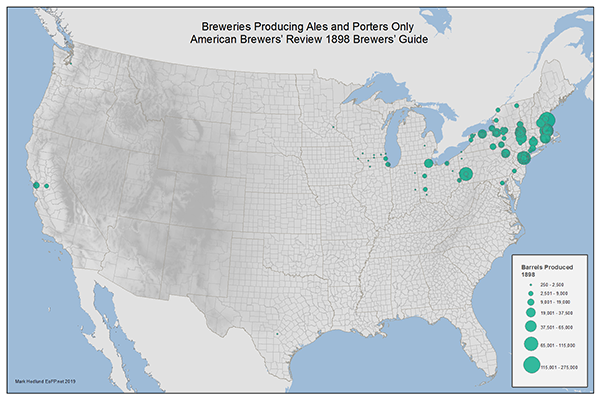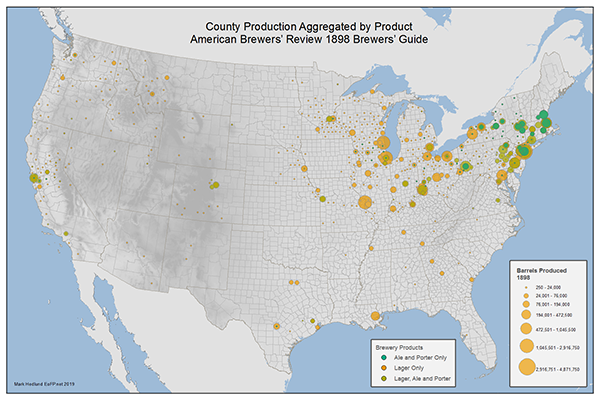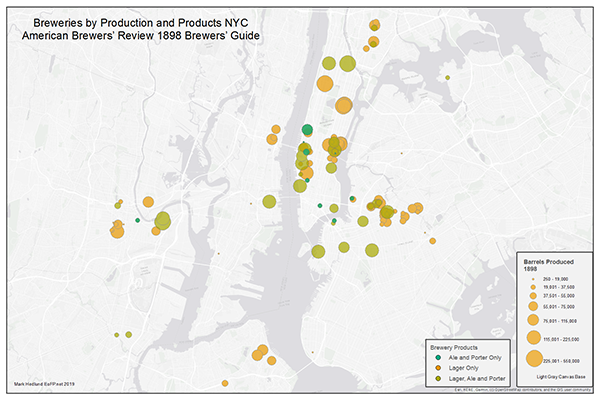Part 2: Ales, Porters, and Lager in the American Brewers' Review 1898 Brewers Guide
This is the second of four articles that focus on the American Brewers' Review 1898 Brewers' Guide.
Introduction: American Brewers' Review 1898 Brewers' Guide
Part 1. An overview of the Brewers' Guide with production figures mapped
Part 3. A brief discussion of bottling, malting, saloons and depots
Part 4: Germans in the brewing industry in 1898
The 1898 Brewers' Guide used a coding system to indicate what types of beer a brewery produced and how much was produced. The guide's codes don't specify how much of which type though. A brewery, for example, might be coded “A P L-E 6”. This indicates that the brewery produced ale, porter and lager and its’ total production was anywhere from zero to 500 barrels. There are also codes for bottling and malting which I will discuss later. In the above example, I have no way of knowing what proportion of total output was ale or porter or lager. I have also digitized and mapped the 1896 Brewers’ Guide from the same publisher. That guide is missing two pages but is useful for comparison. Between 1896 to 1898, at least one brewery is coded as switching production entirely from lager to porter. This seems extremely unlikely given the amount of investment in new equipment that would have been required to meet the demands of what was, at the time, a shrinking market for porter. Given this and other examples, I think the codes in this guide are not always specifically accurate. But in aggregate, the data matches other sources well enough to be useful. I discuss some of these comparisons here.
The difference in breweries making ale, porter or lager is interesting for a number of reasons beyond measuring the drinking fashions of 120 years ago. Ales and porters brewed in the US were mostly British styles whereas lagers were Bavarian and Bohemian. The difference in styles can be used, are often used, as proxies for the ethnicity of both the brewers and the customers of the brewers. This linkage isn’t perfect though and I think the data from this guide shows that. Lagers were introduced in the US in the 1840s. The pale lagers that dominate the global beer market today were invented in Bohemia and Bavaria in the mid-1800s. Their popularity spread rapidly in both continental Europe and the US, but in 1898, as this guide shows, British styles were still being produced in the US in large quantities, especially in the northeast. The technology for producing ales and lagers is different enough that it is reflected in the designs of breweries. But British influences on American lager brewery designs can still be seen in many cases. The late 19th century American industrial brewery was a unique combination of global technologies and architectural influences. The origins of some of these can be deduced from the types of beer the brewery made.
Until the late 1800s, brewers had absolutely no idea how fermentation worked. Brewers of the 19th century attributed the resulting alcohol to strange and mystical forces. Brewers knew that they had to keep their fermenting stock at temperatures lower than the mid-70s Fahrenheit or it would become putrid. Most brewers in Europe and the Americas kept fermenting temperatures between the 60s to low 70s Fahrenheit. Fermenting at these temperatures can produce beers in the ale family in a matter of days. Porter is a blend of aged and fresh beer fermented at temperatures similar to that of ale. The British and other Northern Europeans that colonized North America had traditionally brewed and drank ales. Porter was the product of the world’s first industrial breweries in London in the early 1700s. It was very popular in the English speaking world until the mid-1800s. The brewing industry in the United States produced ales and porters almost exclusively until the mid-1800s when German immigrants introduced a new style of beer- lager.
In the 1400s, brewers in Bavaria started experimenting with brewing in low temperatures (55 Fahrenheit and below). Fermentation at low temperatures slowed the process down and produced different sorts of beers from the usual ales. These experiments were limited to winters for the next few hundred years, producing a special, seasonal product. Fermenting at low temperatures is a months long process rather than the days or weeks for ales. This new type of cold fermented beer took the German word for storage, lager, as its’ name. The brewers of the time had no way of knowing that the low temperatures limited the growth of “top fermenting" yeasts and encouraged the growth of “bottom fermenting" yeast. The differences in strains of yeast, which are major contributors to the characteristics of the resulting beer, weren’t understood until the late 19th century. The craft production of lager spread to Bohemia but was otherwise limited to southern German speaking lands until the 19th century. Lager production and drinking is often conflated with Germany and German immigrants in the United States. But at the mid-19th century height of German immigration to the US, many of the beers produced in Germany north of Bavaria were ales. The pale lagers that became popular in the US were developed in Bohemia (modern day Czech Republic) and Bavaria in the mid-1800s. Pale lagers like Pilsner were introduced to the bulk of Germany at around the same time as they were introduced to the United States. This is why using lager brewing as a proxy for German ethnicity is problematic. It’s true though that almost all of the owners and most of the employees of pre-prohibition lager breweries in US were from Germany or the Austro-Hungarian Empire. It’s not entirely clear to me why his was the case. The customers of lager breweries were from much more diverse backgrounds though.
Lagers quickly gained popularity in the US after they were introduced in Philadelphia in the 1840s. Lager brewing depends on controlled temperatures in the 40s and 50s Fahrenheit for long periods. Brewers in the US tunneled into hillsides in cities like Cincinnati and tunneled underground in cities like St. Louis and Brooklyn to create cool spaces for lager production. Vast quantities of natural ice were used by brewers to control temperature in the warmer months. Brewers located near streams, rivers and ponds that they could harvest ice from in the winter. They often dug shallow basins next to streams into which they would divert water. The still water in the basins would freeze rapidly and could be harvested as ice and the basin refilled again. It was important to stock up on ice in the winter months. Lager production in the warmer months was impossible without it. This helps explain why lager breweries were located in certain areas of cities. Brewerytown in Philadelphia, for example, developed near the Schuylkill River which was a source of natural ice in the winter. Breweries were located along river bluffs in Cincinnati that were easily tunneled into for cool storage. A large lager brewery was built in Boca California, near the Sierra Nevada summit of the Transcontinental Railroad, to take advantage of plentiful natural ice and low temperatures. The need for cold process temperatures also partly explains why there were no lager breweries in the south until the 1880s. Ale breweries required temperature control as well but to a lesser degree and for shorter periods of time.
In the 1880s, mechanical refrigeration machines became available. These machines compressed ammonia vapor with massive steam driven pumps and sprayed the resulting liquid into sealed evaporators. Breweries adopted this new technology rapidly. Mechanical refrigeration broke the link between brewery location and the physical environment. The water needed for the brewing process was often obtained from on-site wells. Barley and other ingredients could shipped in by rail or wagon. Beer was a bulky product prone to spoiling. After the advent of mechanical refrigeration, proximity to market was the most important consideration in locating a brewery. By the time the 1898 Brewers’ Guide was published, mechanical refrigeration had been universally adopted for a least a decade in the industry. The patterns we see in the maps below were created by market location rather than physical or resource factors.

Click on the map for a larger image.
You can see the influence of the waves of German immigration in the second half of the 19th century in the above map. The small-town lager breweries in the agricultural lands of the upper Midwest were primarily operated by Germans and served communities with large German populations. Breweries in the mining and logging towns in the west produced lagers for the most part. The few breweries scattered through the south produced lagers as well. These breweries were often owned and operated by Germans but they served communities of other ethnicities. Ale and porter breweries were mostly found in older urban centers and mostly in the Northeast.
Histories of the American brewing industry tend to give the impression that lager and Germans quickly replaced British beer styles and other ethnicities in the brewing industry after the Civil War. The 1898 Brewers’ Guide shows that there was still a significant amount of ale and porter being produced at the turn of the century. The 1898 Brewers’ Guide listed 1,720 breweries in operation. This is less than the United States Brewers’ Association’s 1,845 and more than the US Census count of 1,507 in 1899. Somewhere between these numbers is probably the truth. All three counted, as breweries, operations that were very small. The 1898 Brewers’ Guide used a system of codes for both of beer produced, whether bottling or not, whether malting barley on site, and for production. Production is coded in 48 ranges with the lowest being “E 6” for less than 500 barrels per year. I’ve changed these ranges to midpoints to sum them. The 1898 guide lists 338 "E 6" sized breweries. A barrel is 31 gallons which is the equivalent of 41 six-packs of 16 ounce bottles. A brewery, and there were many, that produced a few hundred barrels per year could have been housed in a shed. My primary interest in this study is the brewery as an industrial building type. Brewing operations required substantial and permanent structures to produce around 2,000 or more barrels per year. These are the types of operations that interest me most. 1,098 breweries produced 2,000 or more barrels per year in 1898 according to the Brewers’ Guide. Of those, 93 produced ale and porter exclusively. 313 of those produced ale and porter in addition to lager. The 129 breweries of all sizes that brewed ale and porter exclusively produced 2,213,000 barrels in 1898. The 384 breweries that included ale or porter in their offerings produced 11,915,750 barrels in 1898. Total beer production in the US that year was 38,581,750 barrels. The largest brewery producing ale or porter 1898 was Ballantine in Newark New Jersey which produced 450,000 barrels. Frank Jones in Portsmouth New Hampshire produced 275,000 barrels as did James Everard’s in New York City. To my knowledge, Ballantine and Everard’s mostly produced ale at that point. Frank Jones produced ale and porter exclusively. The largest brewery in the country at that time was Pabst in Milwaukee which was producing close to a million barrels of lager per year.

Click on the map for a larger image.
The production of individual ale and porter breweries is symbolized in the map above. These are breweries where no lager was produced at all. The biggest producers of ales and porters aside from Frank Jones also produced lagers and those aren't represented above. This map makes the geographic concentration of the ale and porter market in 1898 clear. In the map below, the outputs of all breweries producing ale and porter only, lager only or all three, are aggregated at the county level. You can see the new lager breweries of the south, especially New Orleans, in this map. The relatively small output of the lager breweries of the rural West and Midwest is clear in this map as is the enormous output of the lager breweries in St. Louis, Milwaukee and Chicago. The production of breweries in New York City (7,560,500 barrels) was more than twice as much as any Midwestern state.

Click on the map for a larger image.
Using the New York City area as an example below you can see that ale and porter breweries were found in the areas that had been urbanized for the longest time. Lager breweries tend to be found in recently developed (in 1898) sections of Queens, Brooklyn, Staten Island and outlying parts of Manhattan and Newark. Only breweries with confirmed locations are placed on the map below. Generally, this means I’ve found the brewery on a fire insurance or other contemporary city atlas. Likewise, ale and porter breweries in the United States tended to be found in the oldest urban areas. This leads to several speculative observations. Older areas with established brewing industries might have been more difficult markets to enter for new German immigrants. German brewers established themselves in cities like Cincinnati, Milwaukee and St. Louis at very early stages in those cities' developments. When Germans arrived in the mid-1800s, cities like Boston had existing brewing industries that may have resisted new entrants. New Orleans hadn’t developed much of a brewing industry before the late 1800s, due to its' hot climate. When mechanical refrigeration became available, German brewers were the dominant ethnic group in the industry nation-wide. New York City had the largest German population of any city in the country but also had many established ale and porter breweries. A large quantity of ale and porter continued to be produced in New York City but an even greater amount of lager was brewed. There were 152 breweries in the New York City area in 1898 that produced a total of 9,778,500 barrels of all types of beer. Those producing ale and porter exclusively, brewed 367,250 barrels. Those producing ale porter as well as lager made 3,996,500 barrels. Those producing lager exclusively brewed 5,776,500 barrels. George Ehret’s Hell Gate brewery on East 92nd Street was the most productive of all in the New York area with 550,000 barrels of lager produced that year.

Click on the map for a larger image.
Part 3. A brief discussion of bottling, malting and more about Germans
All content on these pages Copyright Mark Hedlund 2012-2019. All rights reserved. Use in school projects and with links on social media is always okay. Please send me an email to request permission for any other use: hedlunch@yahoo.com Non-exclusive commercial publication rights for most photos is $25 per image.
